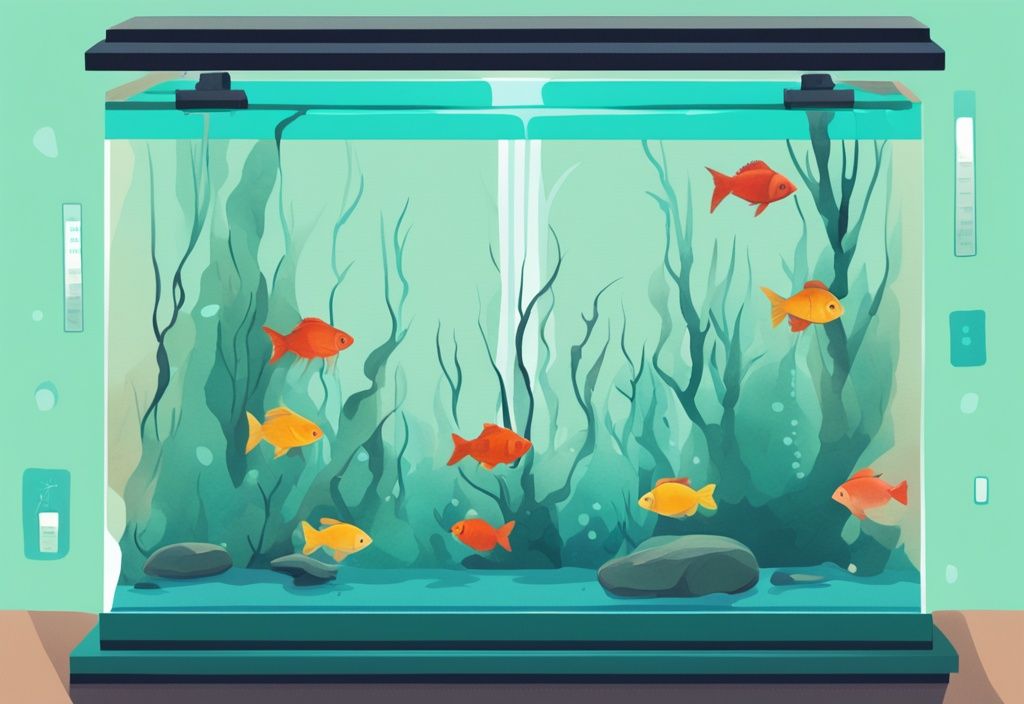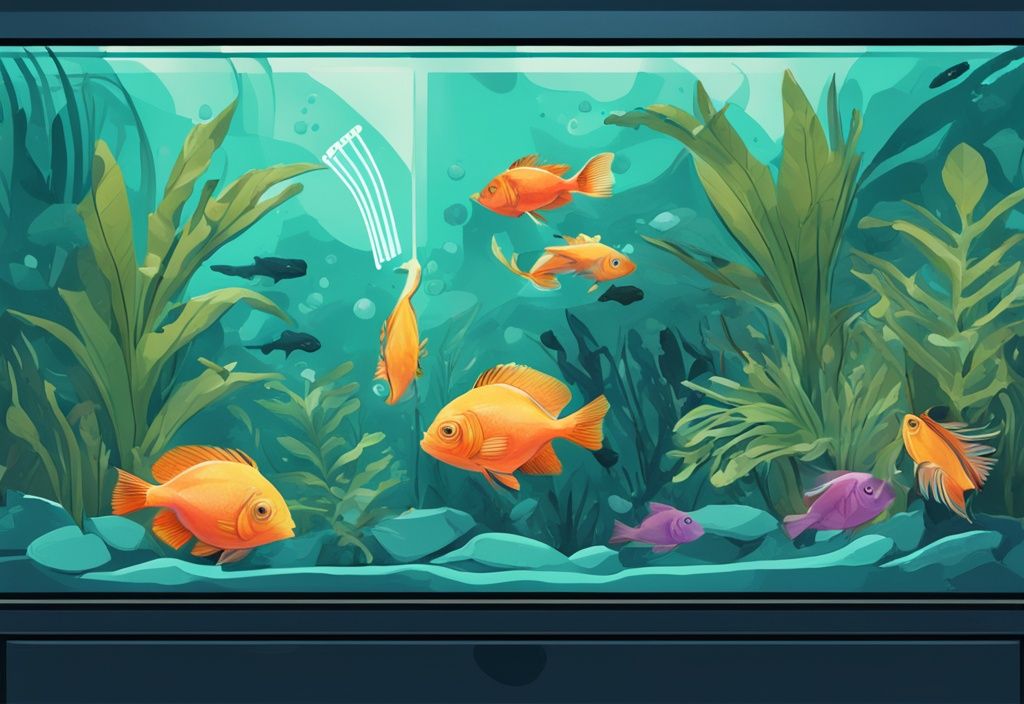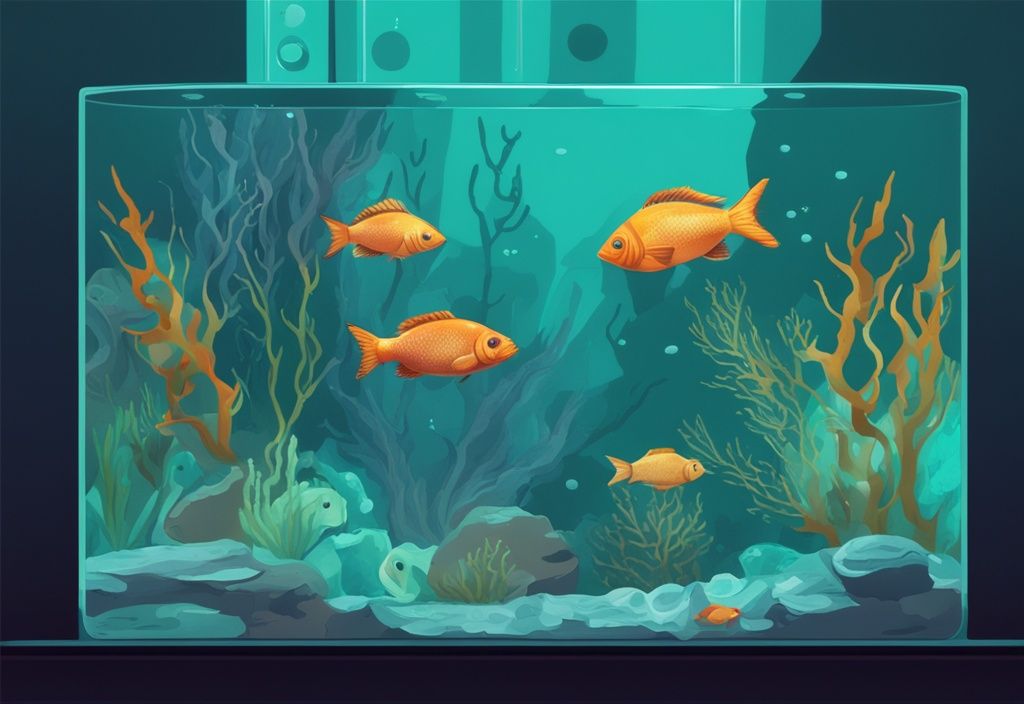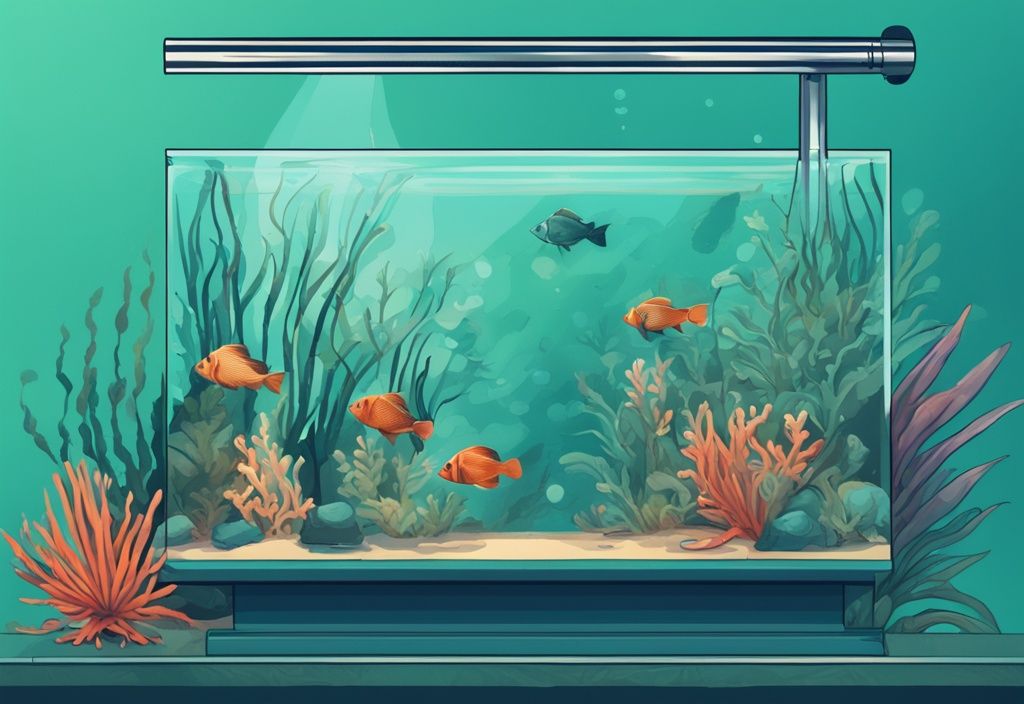Ever wondered, “What temperature should a fish tank be?” Uncertainty ends here. As a seasoned marine biologist, I’m here to take you through the underwater temperature labyrinth, ensuring it doesn’t leave your fish just surviving, but thriving.
This article doesn’t only tell you about necessary temperature conditions for various fish species, but also provides practical tips on creating a stable, healthy aquatic environment. After all, a slight dip or rise in the mercury can mean a drastic change in your fish’s well-being.
Whether you’re dipping your toes into the world of aquaristics or a seasoned hobbyist, this expert guide will act as your reliable compass. Everyone should be privy to the knowledge of creating their perfect underwater Eden. Let’s embark on this deep dive together.
Essential Fish Temperature Requirements
Maintaining the proper temperature in a fish tank is critical for the health and well-being of its inhabitants. Let’s delve into the specific temperature needs for different types of fish:
Tropical Fish Temperature Guidelines
Tropical fish are true lovers of warm water environments, generally flourishing within a balmy range of 75 to 80 degrees Fahrenheit (23.8 to 26.6 degrees Celsius). Imagine this as their tropical paradise. To ensure these conditions, a reliable heater is indispensable, especially during colder months when room temperatures can plummet.
Consistency is the golden rule here. Sudden temperature changes can be quite stressful for tropical fish, potentially leading to health complications. Just like us, abrupt shifts in their living conditions can make them unsettled.
Cold-Water Fish Temperature Basics
Cold-water fish, such as goldfish, are naturally conditioned for cooler climates. These resilient beauties thrive best in temperatures ranging from 60 to 70 degrees Fahrenheit (15.5 to 21.1 degrees Celsius). Think of it as their refreshing, cool alpine retreat.
However, they are less forgiving when it comes to temperature fluctuations.
If their environment overheats, they can become sluggish or even fall ill. Cold-water fish generally don’t need a heater, as they benefit from naturally cooler environments.
Standard Temperature Ranges for Temperate Fish
Temperate fish are a fascinating group, with temperature preferences that can overlap both the tropical and cold-water categories. They generally thrive in a range spanning from 68 to 75 degrees Fahrenheit (20 to 24 degrees Celsius). Maintaining the right balance in a mixed-species aquarium can be delicate, but it’s entirely feasible with thoughtful planning.
When housing these diverse species together, careful attention must be paid to ensure that all inhabitants have compatible temperature requirements. This prevents undue stress and keeps your vibrant aquarium community healthy.
Understanding what temperature should a fish tank be is paramount to the success of your aquatic environment. Each fish species has unique temperature needs, and keeping these conditions stable through proper equipment and monitoring will help your fish thrive, turning your aquarium into a thriving, balanced ecosystem.
The Impact of Water Temperature on Your Fish’s Health
Optimizing the temperature in your fish tank is vital. The following sections will guide you on how different temperature ranges can affect your aquatic pets and the importance of stability. We will explore the consequences of high and low temperatures, the necessity of consistent water conditions, and how sudden changes can cause stress to your fish.
How High Temperatures Affect Your Fish
Maintaining the optimal temperature in your fish tank is crucial for the health of your aquatic pets. Overly warm water can hold significantly less oxygen, which can harm your fish by causing hypoxia. As temperatures rise, fish metabolism and oxygen consumption increase, while the availability of oxygen in the water decreases. This can lead to your fish requiring more food and producing more waste, which, in turn, can compromise water quality.
Additionally, at temperatures above 90°F, beneficial bacteria that aid in breaking down waste can die off, leading to dangerous levels of ammonia and nitrite in the tank.
The Adverse Effects of Low Temperatures on Fish
Low water temperatures also pose serious threats to your fish. When water is too cold, fish activity and appetite decrease, weakening their immune systems. Extended exposure to inappropriate temperatures can stunt their growth, dull their colors, diminish their breeding inclination, and ultimately shorten their lifespan.
Additionally, cold temperatures can make fish lethargic and more susceptible to diseases, stressing the importance of maintaining a consistent and appropriate temperature range in your tank.

Stability of Water Temperature: Is it Important?
Consistency in water temperature is critical for fish health. Rapid or frequent temperature changes are universally stressful for fish and can lead to immune suppression, making them more susceptible to diseases. To avoid these issues, an accurate and reliable thermometer should be used to frequently monitor the water temperature.
This will help in maintaining a stable environment where your fish can thrive without the risks associated with fluctuating temperatures.
Fish Stress Caused by Sudden Temperature Changes
Sudden changes in water temperature can have immediate and severe effects on your fish. A rapid drop in temperature can trigger parasite outbreaks such as Ick, which is highly stressful and potentially fatal for fish.
Moreover, drastic temperature changes can cause fish to go into shock, showcasing abnormal behavior, loss of appetite, and weakened health. Managing your aquarium’s temperature carefully and using a reliable thermometer can prevent such stressful and harmful situations for your aquatic pets.
By understanding the intricacies of what temperature should a fish tank be, you can ensure a healthier and more stable environment for your aquarium inhabitants. Regular monitoring and appropriate measures play pivotal roles in preventing the adverse effects caused by improper water temperatures, thereby fostering a thriving aquatic ecosystem.
How To Manage Your Aquarium’s Temperature
A Quick Guide on Choosing and Using Aquarium Thermometers
Maintaining the right temperature in your fish tank is essential for the well-being of its inhabitants. Therefore, having a reliable aquarium thermometer is a must for every aquarium owner. Digital thermometers are highly recommended due to their accurate readings and ease of use.
However, stick-on and floating thermometers also provide good visibility and are useful for quick checks. Regular monitoring with an accurate thermometer will help ensure a stable and optimal temperature, avoiding stress and potential health issues for your fish.
Setting Up Your Aquarium Heater Correctly
Different Types of Heaters and Their Unique Benefits
Selecting the appropriate type of aquarium heater is crucial for maintaining the correct water temperature. Submersible heaters are fully placed underwater, offering consistent and even heating throughout the tank. Hang-on heaters, while easier to access and adjust, might not distribute heat as uniformly.
For larger setups, inline heaters, which are installed outside the tank, are particularly effective and often deliver excellent performance. Choosing the right heater type helps create a stable environment, ensuring your fish thrive.
How to Determine The Right Heater Wattage for Your Tank
Determining the right wattage for your aquarium heater depends on the size of your tank and the ambient room temperature:
- A 20-gallon tank requires a 100-watt heater
- A 55-gallon tank needs a 175-watt heater
- A 100-gallon tank should have a 300-watt heater
Smaller tanks typically need a higher wattage per gallon (around 5 watts per gallon), whereas larger tanks require less (approximately 3 watts per gallon). Using two heaters can prevent overheating and provide a backup option, enhancing reliability and safety.
Simple Tricks to Cool an Overheated Aquarium
When your fish tank overheats, employing simple cooling strategies can make a significant difference. One effective method is using a fan for evaporative cooling. Removing the tank’s top cover and replacing it with screening can also help, especially when combined with a fan to facilitate air circulation.
Placing frozen water bottles in the tank or filter provides controlled cooling and can help manage high temperatures. For persistent heat issues, investing in a chiller is advisable, particularly for reef aquariums which are more sensitive to temperature changes.
How to Prevent Temperature Risks from Your Surrounding Environment
Preventing temperature risks starts with situating your aquarium in a stable environment. Avoid placing tanks near windows, doors, radiators, or heating/cooling vents, as these areas can cause dramatic temperature fluctuations. Regularly monitor the tank during extreme weather conditions—both hot and cold—to ensure stability. If you’re curious about the dietary needs of your aquatic pets, you might want to know what aquarium snails eat to maintain a healthy tank environment. Ensure that your tank has adequate water circulation, which helps distribute heat evenly and prevents hotspots, contributing to a consistently healthy environment for your fish.
The Impact of Lighting on Aquarium Temperature Control
Lighting can significantly influence the temperature of your aquarium water. Monitoring and potentially adjusting the type and duration of your lighting can help manage heat levels. LED lights, for example, typically produce less heat compared to traditional fluorescent or incandescent lights, making them a preferable option.
Careful selection and thoughtful placement of your lighting fixtures can mitigate unnecessary heating, ensuring your tank maintains a stable and suitable temperature.

Fish Species-Specific Temperature Guidelines
Tropical fish and cold-water fish have distinct temperature needs. Understanding these requirements is crucial to maintaining a healthy and thriving aquarium environment for each species.
Ideal Temperatures for Common Tropical Fish
Tropical fish like Neon Tetras, Guppies, and Angelfish flourish in water temperatures ranging from 75 to 80 degrees Fahrenheit (23.8 to 26.6 degrees Celsius). These vibrant species are akin to Goldilocks, needing their environment to be “just right.” They are exceptionally sensitive to temperature changes, which necessitates consistent monitoring and adjustments.
Imagine having a thermostat at home that adjusts to just a degree or two off your comfort zone – that’s how your tropical fish feel! It’s essential to research the specific temperature preferences for each fish species you have. Though many tropical fish share a common range, some may have unique needs that significantly impact their overall health and vibrancy.
Preferred Temperatures for Popular Cold-Water Fish
Goldfish and Koi, cherished staples in many home aquariums, thrive in cooler water. Their optimal range is between 60 to 70 degrees Fahrenheit (15.5 to 21.1 degrees Celsius). Unlike their tropical counterparts, these fish don’t need heaters. However, they react poorly to high temperatures, often suffering from heat stress when the water warms up.
Think of these cold-water fish as preferring a perpetual spring climate. It’s crucial to maintain a cool and consistent environment for their well-being. Regular temperature checks are necessary to ensure that their habitat stays comfortable and stable.
Optimal Betta Fish Temperature Conditions
Betta fish, known for their vibrant colors and flowing fins, require water temperatures of around 78 to 80 degrees Fahrenheit (25.5 to 26.6 degrees Celsius) to thrive. Betta fish are particularly sensitive to temperature swings, much like how we feel when the room temperature suddenly drops or rises significantly.
Maintaining a stable temperature is vital for their health, as even minor fluctuations can lead to stress and disease susceptibility. Ensuring precise control over their environment through reliable heating and frequent monitoring is non-negotiable. A high-quality aquarium thermometer can be your best ally to keep these conditions optimal.
Breeding Fish Temperature Requirements: What You Need to Know
Breeding fish often have specific temperature needs distinct from their typical habitat ranges. Tropical species, for instance, usually require the higher end of their temperature spectrum to foster successful reproduction. This warmth is necessary for effective breeding.
On the flip side, cold-water species may need slightly lower temperatures to stimulate breeding behaviors. Think of it as these fish wanting a specific type of “mood lighting” – only in their case, it’s temperature. Proper research into the breeding temperatures of each species is essential. These adjustments can be critical for fostering a favorable breeding environment, ensuring your fish have the best chance at successful reproduction.
Pro Tips to Maintain an Optimal Aquarium Temperature
Understanding how to maintain an optimal aquarium temperature is crucial for the well-being of your fish. From regular monitoring to seasonal adjustments, each aspect plays a pivotal role in keeping your aquatic environment healthy and stable.
The Secret to Regularly Monitoring and Adjusting Aquarium Temperature
To effectively monitor and adjust your aquarium temperature, establish a regular routine. Frequent checks with a reliable thermometer ensure stable conditions. Using two heaters can provide even temperature distribution and act as a safety measure if one fails.
Gradual adjustments to heater settings are vital to prevent sudden changes that could stress your fish. By incorporating these habits, you’ll create a nurturing environment where your aquatic life can thrive.
How to Match the Temperature of Your Replacement Water
Matching the temperature of replacement water during changes is essential to avoid shocking your fish. Always use a separate thermometer to verify the new water’s temperature, ensuring it aligns closely with the tank’s temperature.
This practice maintains stability and supports the overall well-being of your aquatic pets. For those looking to adjust their tank’s position, here’s a useful guide on how to move a fish tank without emptying it. Consistency in this step helps prevent unnecessary stress and promotes a healthy environment for your fish.
Overheating Your Aquarium During Summer: How to Avoid It
Preventing your aquarium from overheating during summer is crucial for fish health. Utilizing a fan or air conditioning to keep the room cool can significantly help. Enhancing water movement increases oxygenation and promotes evaporative cooling.
Additionally, adjusting your lighting schedules to reduce heat output during the hottest parts of the day can protect your tank from excessive temperature rises. These measures ensure a comfortable habitat for your fish, even in the peak summer months.
Safely Introduce New Fish to Your Tank’s Temperature
Acclimatizing new fish to your tank’s temperature is critical. Start by floating the bag with the new fish in the tank water for 15-30 minutes. This gradual adjustment helps the fish acclimate and minimizes stress.
Mixing tank water with the bag water gradually further aids in adjusting the new fish to your tank’s water chemistry and temperature. By following these steps, you ensure your new additions transition smoothly into their new home.

How to Ensure Consistent Aquarium Temperature
Maintaining a consistent aquarium temperature is fundamental for a healthy environment. Regular cleaning and upkeep of the tank and its equipment are vital practices. Avoid overstocking, as it can raise water temperature and create stress.
Periodic monitoring and adjustments of heating and cooling devices ensure the aquarium stays within the optimal temperature range. These practices are essential for understanding what temperature should a fish tank be and maintaining it efficiently.
By implementing these thoughtful approaches, you support the thriving lives of your aquatic friends, providing them with a balanced and stable ecosystem.
Conclusion
Ensuring proper water temperature is crucial for the health and well-being of your fish. Stability and consistency in water temperature are paramount, as fluctuations can lead to stress and disease. But what temperature should a fish tank be?
Different fish species have unique temperature needs. Generally, tropical fish thrive in warmer waters, while cold-water species prefer cooler conditions. Regular monitoring of the water temperature is essential to maintain an optimal environment for your aquatic pets.
Using reliable equipment such as accurate thermometers and appropriately sized heaters will assist in achieving the right temperature. It’s equally important to place your aquarium away from windows, heating vents, and other sources that can cause temperature fluctuations.
Having a clear understanding of the specific temperature requirements for your fish species is paramount. Tropical fish typically require temperatures ranging from 75 to 80 degrees Fahrenheit, while cold-water fish are comfortable in the range of 60 to 70 degrees Fahrenheit. Catering to these temperature preferences helps in creating a thriving habitat that minimizes the risk of stress and disease.
In conclusion, knowing what temperature should a fish tank be and maintaining it through regular monitoring, proper equipment, and optimal placement ensures the best possible environment for your aquatic pets. Your dedication to understanding and meeting their temperature needs will lead to healthier, happier fish and a more vibrant aquarium.
Frequently Asked Questions About Aquarium Temperatures
What’s the Best Temperature Range for Most Aquariums?
A suitable temperature range for most fish tanks is 76° to 80°F (25° to 27°C). This temperature range is ideal for many fish species and helps maintain their health and activity levels. Think of it as giving your fish the perfect climate to thrive in, similar to a comfortable, cozy home.
My Fish Tank Overheated, Now What?
If your fish tank overheats, try cooling strategies such as using fans, ice packs, or performing water changes with cooler water. Gradually bringing the temperature down is crucial—avoid sudden drops to prevent stressing the fish. Imagine stepping into an icy shower on a hot day; it’s shocking and uncomfortable for your fish, too.
What Should I Do If My Aquarium Heater Fails?
When your aquarium heater fails, using a backup heater and keeping an extra thermometer on hand can be lifesavers. Manually adjust the room temperature and use emergency heating methods like warm water bottles to keep the water at the right temperature. It’s like having a spare tire for your car—essential for unexpected emergencies.
How Often Do I Need To Check My Aquarium Water Temperature?
Checking the water temperature daily is recommended to ensure stability and address any sudden changes immediately. This practice helps maintain a consistent environment for your fish. Think of it as part of your morning routine, like checking the weather forecast—it’s all about preparedness.
Can Rapid Changes in Temperature Really Harm My Fish?
Rapid temperature changes can indeed harm your fish, causing stress, shock, and increased susceptibility to diseases. In severe cases, it can be fatal. Stabilizing the temperature is crucial to prevent these issues. Picture yourself in a sudden cold snap without a jacket; the same principle applies to your aquatic pets.
What Temperature Do Betta Fish Thrive In?
Betta fish thrive in temperatures around 78 to 80 degrees Fahrenheit (25.5 to 26.6 degrees Celsius). Maintaining a stable temperature within this range is essential for their well-being. It’s like finding just the right level of warmth and comfort that keeps them active and happy.
Is a Heater Necessary for Temperate Climate Aquariums?
In temperate climate aquariums, heaters may not be strictly necessary, but monitoring is crucial. Ensuring the tank stays within the preferred temperature range for temperate fish is important to avoid fluctuations that can stress the fish. Think of it as adjusting the thermostat in your home according to the season.
How to Tell if Your Fish Are Stressed Due to Improper Water Temperature?
Signs of stress due to improper water temperature include abnormal swimming patterns, loss of appetite, lethargy, and gasping at the surface. These behaviors indicate that the fish may be under stress from temperature issues. It’s akin to observing a friend who’s not feeling well; they might move slowly or seem disinterested in food.
What Are the Signs My Fish Are Suffering from Temperature Stress?
Symptoms of temperature stress in fish can include erratic swimming, color changes, clamped fins, and increased susceptibility to disease. Monitoring these signs allows for prompt action to correct the temperature. Imagine the way you’d feel chills with a fever; your fish exhibit visible signs when they’re uncomfortable.
Keeping a Stable Temperature During Water Changes: How Can I Do it?
To maintain a stable temperature during water changes, match the new water’s temperature to that of the tank, use gradual mixing, and avoid adding water that is too hot or cold. This practice prevents shocking the fish and keeps their environment stable. It’s like stirring a cup of hot tea with just the right amount of cooler water to drink comfortably.
